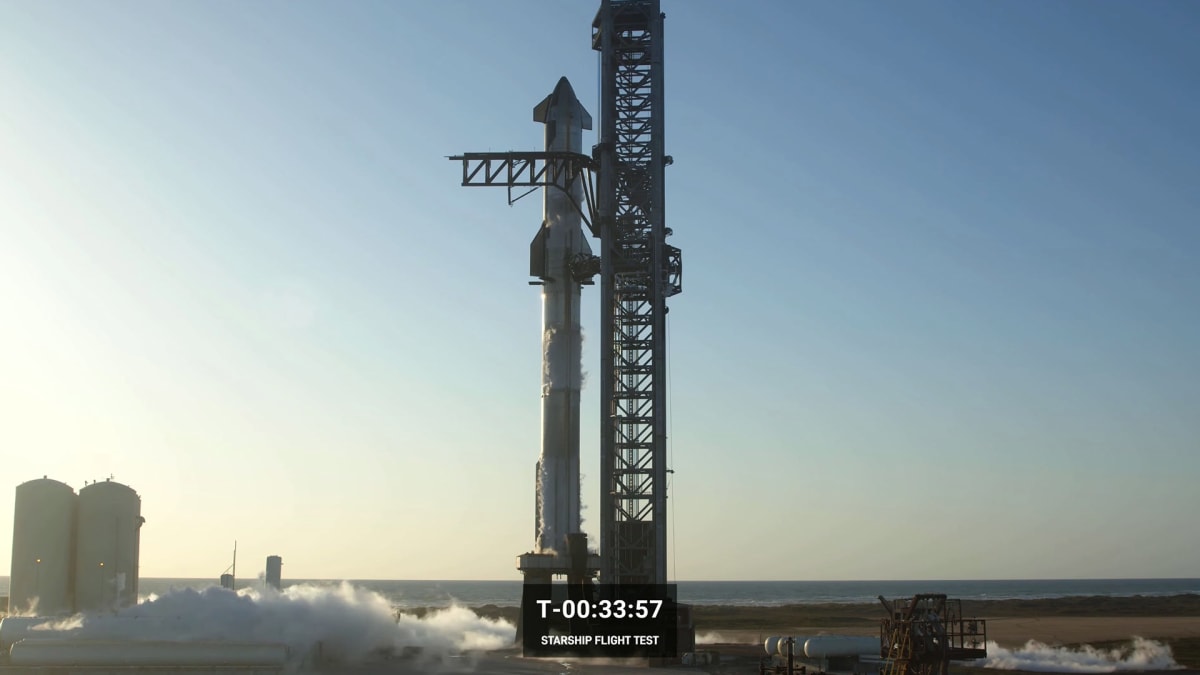
Elon Musk on April 14 had promised: "Success maybe, excitement guaranteed!"
There was excitement, surely.
Five minutes before the blastoff, television screens turned to Boca Chica, Texas, where Musk and SpaceX were attempting the first orbital flight of Starship, the most powerful rocket ever made.
This rocket is the vehicle with which Musk has promised -- himself and the world -- to conquer Mars. He says humans will inhabit the red planet in our time. This first flight therefore had historical significance for mankind.
A Small Delay, and Wary Onlookers
At 9:30 a.m. U.S. Eastern, when the liftoff was scheduled, nothing happened.
You could read the disappointment on the faces of SpaceX employees and presenters on the firm's YouTube channel, which broadcast the event live.
But three minutes later a reassuring message arrived, saying everything had been reviewed and the countdown of around 45 seconds could restart.
"It looks like they're clearing all the flags, and we're gonna release that T-minus 40 seconds," one of the presenters announced, to the delight of the two others seated next to him.
"That is amazing news," another presenter said excitedly.
For his part, Musk, who was in the control room, continued to tweet to increase the energy around the event and to remind himself of the historic nature of this flight.
"10 minutes to launch," he tweeted at 9:17 a.m. ET.
"T-0 in 4 mins," he posted seven minutes later.
Starship Blasts Off -- and Then Blasts Apart
Around 9:34 a.m. ET, history was made. Starship blasted off to the cheers of the many spectators watching from South Padre Island, several miles from the Boca Chica Beach launch site, according to footage released by SpaceX. The public could not access the site.
But just minutes after liftoff, the rocket exploded and crashed into the Gulf of Mexico. No humans were on board.
"We are awaiting stage separation," one SpaceX presenter said just before the explosion. "Starship should separate from the super heavy booster."
"Right now it looks like we saw the start of the float but obviously we're seeing from the ground cameras. The entire Starship stack could turn or rotate. We should have had separation by now. Obviously, this does not appear to be a normal situation," another presenter said.
The plan called for the booster to peel away from the spacecraft minutes after liftoff, but that didn’t happen. The rocket tumbled and then exploded four minutes into the flight, plummeting into the gulf.
After separation, the spacecraft was supposed to continue east and attempt to circle the world, before crash-landing in the Pacific near Hawaii.
"As if the flight test was not exciting enough, Starship experienced a rapid unscheduled disassembly before stage separation," the company explained on Twitter, Musk's microblogging platform.
"Teams will continue to review data and work toward our next flight test," it continued, adding that "today’s test will help us improve Starship’s reliability as SpaceX seeks to make life multiplanetary."
Musk congratulated SpaceX teams and said the company would use the data collected for the next attempt scheduled in "a few months."
"Congrats @SpaceX team on an exciting test launch of Starship! Learned a lot for next test launch in a few months," he said on Twitter.
Starship's first orbital flight was scheduled for April 17 but was later rescheduled for April 20.
Why Is Starship Important?
The orbital launch of Starship is designed to represent a leap forward for humanity, by reaching the moon, then Mars, while carrying tons of cargo.
Starship, a next-generation rocket, refers to the space-transport vehicle and the upper stage of the launcher. The main stage -- that is, the booster needed to launch the Starship -- is called Super Heavy.
It is designed to quickly replace the entire current range of SpaceX launchers and separate freight and manned transport systems.
These are the Falcon Heavy and the Falcon 9, used for launching satellites, resupplying the International Space Station, and rotating crews.
SpaceX has tested the second-stage Starship spacecraft, but only on high-altitude flights rather than in orbit. The Super Heavy, on the other hand, has yet to fly.
Successful testing of the spacecraft will pave the way for NASA to use a modified version of the Starship spacecraft to land the first woman and first person of color on the lunar surface, a mission that set to take place no sooner than 2025.
The vehicle could also be deployed to ferry supplies to the moon to help build NASA's proposed moon base. NASA is currently targeting the late 2030s for the first astronaut mission to Mars.







